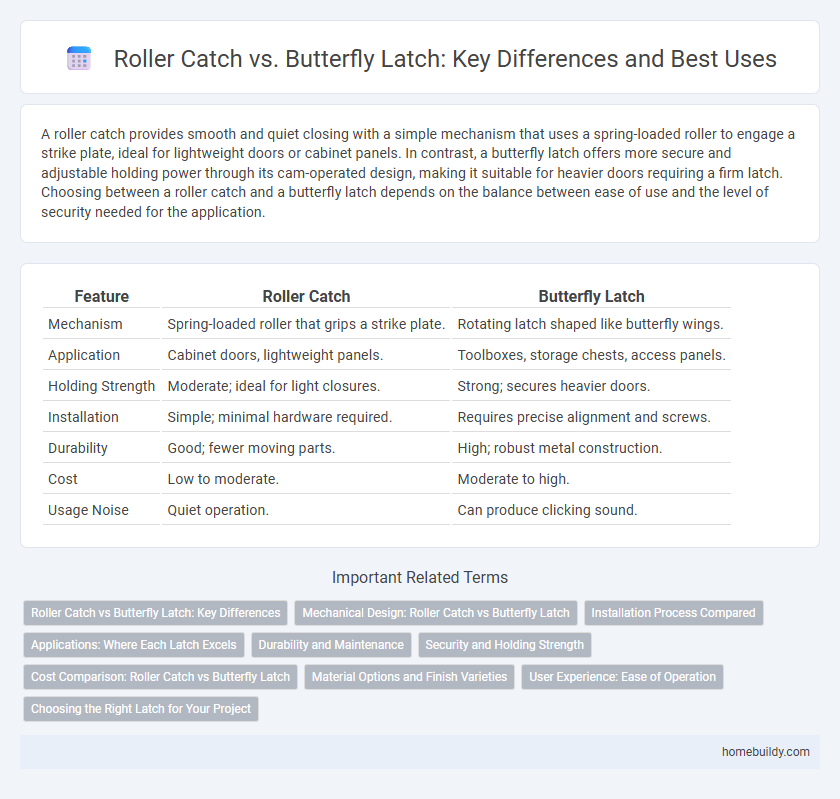A roller catch provides smooth and quiet closing with a simple mechanism that uses a spring-loaded roller to engage a strike plate, ideal for lightweight doors or cabinet panels. In contrast, a butterfly latch offers more secure and adjustable holding power through its cam-operated design, making it suitable for heavier doors requiring a firm latch. Choosing between a roller catch and a butterfly latch depends on the balance between ease of use and the level of security needed for the application.
Table of Comparison
| Feature | Roller Catch | Butterfly Latch |
|---|---|---|
| Mechanism | Spring-loaded roller that grips a strike plate. | Rotating latch shaped like butterfly wings. |
| Application | Cabinet doors, lightweight panels. | Toolboxes, storage chests, access panels. |
| Holding Strength | Moderate; ideal for light closures. | Strong; secures heavier doors. |
| Installation | Simple; minimal hardware required. | Requires precise alignment and screws. |
| Durability | Good; fewer moving parts. | High; robust metal construction. |
| Cost | Low to moderate. | Moderate to high. |
| Usage Noise | Quiet operation. | Can produce clicking sound. |
Roller Catch vs Butterfly Latch: Key Differences
Roller catch and butterfly latch differ primarily in design and application; roller catches use a spring-loaded roller mechanism for smooth, quiet door closing, while butterfly latches employ a rotating wing-shaped catch for secure fastening. Roller catches are ideal for interior cabinet doors requiring subtle closure without a locking feature, whereas butterfly latches provide stronger hold suited for cabinets needing more stability or occasional locking. The choice between roller catch and butterfly latch depends on factors such as ease of installation, holding strength, noise level, and door type.
Mechanical Design: Roller Catch vs Butterfly Latch
Roller catches utilize a rotating cylinder mechanism that provides smooth engagement and release, offering consistent pressure and noise reduction in door closure systems. Butterfly latches feature a pivoting cam design, which creates a more positive locking action but can require higher installation precision to ensure proper alignment. Mechanical design differences in roller catches emphasize ease of use and durability, while butterfly latches prioritize secure fastening and resistance to forced entry.
Installation Process Compared
The installation process of a roller catch is straightforward, typically requiring only two screws to secure the catch and strike plate, making it ideal for quick and easy fitting on cabinet doors. In contrast, a butterfly latch demands more precise alignment and additional steps, including embedding a recessed strike that can extend installation time and complexity. Roller catches offer simplicity and speed, whereas butterfly latches provide a more secure fit at the cost of a more involved installation procedure.
Applications: Where Each Latch Excels
Roller catches excel in applications requiring smooth, silent door closures such as cabinet doors and interior panels due to their simple mechanism and low maintenance. Butterfly latches are ideal for heavier doors or equipment enclosures where secure fastening and vibration resistance are critical, like industrial cabinets or access panels. Choosing between the two depends on the door weight, frequency of use, and the desired level of security or noise reduction.
Durability and Maintenance
Roller catches offer superior durability due to their simple design and fewer moving parts, reducing wear and tear over time compared to butterfly latches. Maintenance for roller catches is minimal, often requiring only occasional lubrication to ensure smooth operation, whereas butterfly latches may need more frequent adjustments and part replacements. The robust construction of roller catches makes them ideal for high-traffic doors where long-term reliability is critical.
Security and Holding Strength
Roller catches provide moderate holding strength suitable for lightweight doors but lack robust security features compared to butterfly latches. Butterfly latches offer enhanced holding strength through their spring-loaded mechanism, making them ideal for doors requiring reliable security and resistance to forced entry. Security-focused applications benefit from butterfly latches due to their sturdier construction and secure locking capability.
Cost Comparison: Roller Catch vs Butterfly Latch
Roller catches typically offer a lower upfront cost compared to butterfly latches due to simpler materials and manufacturing processes. Butterfly latches, while more expensive, provide enhanced durability and security that may justify the investment in high-traffic or exterior applications. Cost efficiency depends on project requirements, with roller catches favored for budget-sensitive interiors and butterfly latches preferred for long-term value in demanding environments.
Material Options and Finish Varieties
Roller catches typically feature durable materials such as stainless steel, brass, and zinc alloy, offering robust corrosion resistance and smooth operation in various environments. Butterfly latches often come in steel and aluminum options, emphasizing lightweight construction with finishes like powder coating and anodizing for enhanced aesthetic appeal. Both hardware types present multiple finish varieties, including satin, chrome, and antique brass, allowing for versatile applications in interior and exterior door systems.
User Experience: Ease of Operation
Roller catches provide a smooth and effortless operation, making door handling easy and intuitive for users, especially in residential settings. Butterfly latches require more precision to align and engage, which can challenge users seeking quick and frictionless closure. The simple mechanism of roller catches enhances user experience by minimizing resistance and ensuring consistent, reliable door engagement.
Choosing the Right Latch for Your Project
A roller catch offers smooth, quiet operation ideal for lightweight doors and cabinets, while a butterfly latch provides a more secure hold suitable for heavier doors and high-traffic areas. Selecting the right latch depends on factors like door weight, frequency of use, and desired security level. For projects needing ease of use and subtle closure, roller catches excel, whereas butterfly latches are preferred for durability and stronger retention.
Roller catch vs Butterfly latch Infographic

 homebuildy.com
homebuildy.com